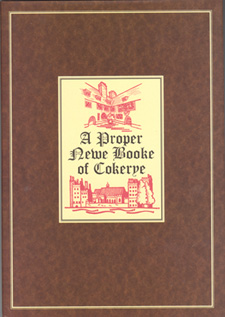Copyright and
Republication
Notice
This article is Copyright 2002 to "Serve It Forth!".
All rights reserved.
The author retains all publication rights. Crossposting of this article without specific permission is prohibited. This article can be printed for personal use.
Reprint or republication of the article is allowed in not-for-profit newsletters only under the following conditions:
You cannot edit, abridge, or change the article in any way from the text presented here.
You must credit the source of the articles as
Serve It Forth!, October 2002.
You must mail two copies of the publication to:
1245 Allegheny Drive
Colorado Springs, CO
80919-1516
One copy will be kept on file at Serve It Forth! and the other will be forwarded on to the author.
Author Profile

A Review of A Proper Newe Booke of Cokerye
by Johnna Holloway
On the left hand side of the book appears the original text in facsimile. On the facing right page appears Anne Ahmedís carefully interpreted text for the modern reader. It is the best of both worlds. Ahmed has not reproduced the original text but expands upon it. Thus, we are told, ďBrawn (usually wild boar meat) is best from a fortnight before Michaelmas (about mid September) until Lent (between February and March). Beef and bacon are good all year round.Ē This makes the work accessible to a modern reader who is not already well versed in the language of 16th century English culinary texts.
The editor, Anne Ahmed, is the wife of the present Master of the College, a distinction that she shares with Margaret Parker, the presumed owner of this book. The original cookbook was given to the college as part of Matthew Parkerís donation in 1574. Parker, 1504-1575, became the 14th Master of Corpus Christi College at Cambridge in 1544 and served until 1553. He married Margaret Harleston in 1547. She thus became the first Masterís wife at Corpus Christi College. Parker later served as Archbishop of Canterbury during the reign of Elizabeth I. Besides providing the modern text to accompany the original text, Anne Ahmed has also provided a very valuable introduction that establishes Matthew and Margaret Parkerís places in English history. [This should prove most helpful for members of an American audience who probably have little idea as to who Matthew Parker was or what place he holds in English history.]
So much with this edition of A Proper Newe Booke of Cokerye has been done right. The line illustrations while simple are yet very appropriate, and are done in contrasting red. The other illustrations are equally well-chosen. The adapted recipe section, while not comprehensive, gives one a flavor of what might be possible should one want to adapt the original recipes and serve them today. It should be mentioned that the Worshipful Company of Cooks of London provided funding in part for the publication. Lastly and this is most important, the volume neatly fills the gap in making available the undated edition for purposes of study and comparison. Given that the editions of 1545, 1575, and 1576 are available either on microfilm (through the filming done by UMI) or available now online through the EEBO project (as offered by Proquest), with this volume in hand, one can survey and study all the known editions of this work and their subsequent influence on the cookery books of the late 16th century. Certainly the authors Thomas Dawson and A.W. made use of this work when compiling their own volumes in the 1580ís.
There are a few minor bibliographic quibbles that one might have with the work. The bibliography section mentions Peter Brearsí short booklet or chapter Tudor Britain, but does not mention his more encompassing work on Tudor cookery entitled All the Kingís Cooks. The Tudor Kitchens of King Henry VIII at Hampton Court Palace. {London: Souvenir Press Ltd., 1999. ISBN: 0 285 63533 6.} Readers might find useful another work that is unmentioned: F. G. Emmisonís Tudor Secretary. Sir William Petre at Court and Home {1961; reprint by London: Phillimore, 1970} Documenting the life of Sir William Petre (1505-1572), Emmison includes material on life in another Tudor household, including a great deal of information on food and drink, day to day menus, and household expenditures. The fact that Matthew Parker and William Petre knew each other and corresponded only adds to the value that can be gained by perhaps reading Emmison in conjunction with A Proper Newe Booke of Cokerye. Lastly nowhere in the volume is it given but it ought to be stated that the undated edition of A Proper Newe Booke of Cokerye is properly known as STC (2nd) 3366.
In conclusion it can be said that the work is charming, extremely useful for its presentation of facsimile and modern texts, and extraordinarily valuable for any scholars and readers of English culinary history.
Bibliographic Information:
A Proper Newe Booke of Cokerye. Margaret Parkerís Cookery Book. Edited by Anne Ahmed. Cambridge, U.K.: Corpus Christi College, 2002. Hardcover. [112 pp.] ISBN: 0-9504261-3-X. [A Facsimile by John Cleaver of the undated complete text of the Corpus Christi copy of A Proper Newe Booke of Cokerye, with an interpretation by Anne Ahmed, pp. 23-81. Preface, Acknowledgements, and Introduction by the editor Anne Ahmed, pp. xi-xiii and pp.1-22. Also includes a Foreword by Christopher de Hamel, pp. vii-x; Recipes (adapted from the text), pp. 83-97. Bibliography, pp. 98. Original Illustrations by Chihiro Mizuta; numerous other illustrations.]